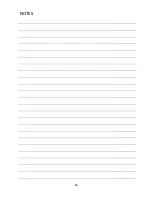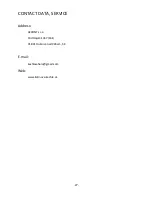
-16-
resistant gloves, otherwise there is a risk of burning.
Do not throw the explosive objects to the proximity of, onto or inside the stove or the
furnace.
The ash shall be carefully taken out to a dedicated container after it had cooled down.
Use heat-resistant gloves.
Do not use damaged, non-functioning stove. The user shall be responsible for the
professional repair.
It is forbidden to use waste, wood sawdust, wood chippings, loose substances, powder
coal, plastic, rubber, liquid fuel, liquids, alcohol, gas, any objects soaked with volatile and
crude oil substances, clothes, etc. as a fuel. Only the fuel recommended by the
manufacturer of the stove may be used.
-
When heating using the stove it is necessary to always ensure the reasonable venting,
also in the case of the concurrent operation with other thermal device.
-
Regularly check the amount of ash deposited in the fume duct and elbow bends, as well
as in the shafts of the stove, minimally once every three months. If necessary, clean them.
-
In the case of fire in the chimney, you must close all the air bleeds of the stove as soon as
possible. Immediately start closing all the inlet controls to minimum, completely close the
ash-cab door. Do not open the loading door, do not open the top round cover. Immediately
call firemen and inform them about the event and its place.
-
The term "Stove Operation" covers the process, from the moment of the fist ignition of fuel
in the stove till the complete burning out of the fuel and the extinguishing of all hot coals in
the stove, including the ash-can and at the same time the cooling down of the entire surface
of the stove to a pleasantly sensed temperature when touching it.
-
During the stove operation, continuously check the stove function and fire safety. It is
necessary to check the following:
-
The condition of the fuel in the stove, the position of the air sucking regulation
controls , the position of loading door, ash-can door and the amount of ash in it (do
not let it get filled with ash to the maximum capacity as this impairs the economy
and ecology of burning. Up to ca ¾ of capacity would be enough.
-
Notice the character of fire in the various phases of burning, its changes in shape,
colour and sound.
-
Notice the grill, whether it is not clogged with ash,
-
Notice whether the loading door is always correctly closed.
-
The increased attention should be paid to the present persons under the influence
of alcohol or narcotics, diseased, weak and paralysed persons.
-
Notice whether someone placed an unsuitable object to the proximity of the
heating or cooling down stove.
-
In particular, warn the children of the possible risk of burning and always take care
so that they would not get to the dangerous distance from the stove, in order to
prevent their burning and falling over, despite that they are sufficiently away from
the stove at first glance.
-
Prevent the free uncontrolled movement of animals in the proximity of the stove.
-
Do not put any live animals and any objects into, onto the stove, into the furnace













































